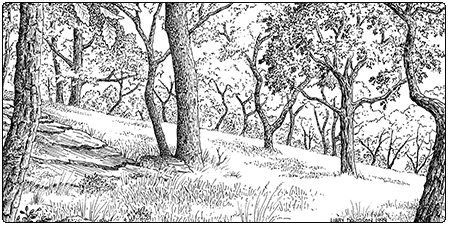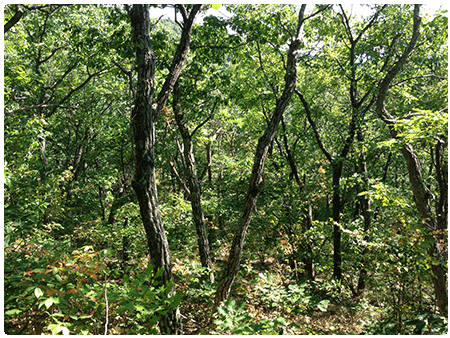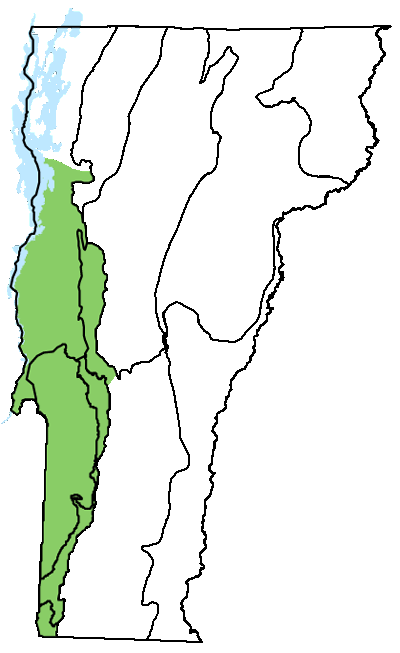Ecology and Physical Setting
Once imaginatively dubbed “elfin oak woodlands,” these intriguing places are unlike any other natural community in Vermont. Dry Chestnut Oak Woodlands, with their widely spaced trees and grassy lawns, evoke distant savannahs and seem far removed from the typical Vermont woods. They occur on south-facing upper hillslopes in southwestern Vermont. Soils are acidic, excessively drained, and often very rocky. These woodlands are southern in character with a prevalence of oaks, particularly chestnut oak. The overstory oaks are short in stature, and the crowns frequently appear gnarled, with abundant low, spreading branches. The trees are farther apart than in typical forests, and the canopy is more open. Midstory or understory trees and shrubs are widely scattered.
Vegetation
These woodlands are open and park-like. Trees are abnormally short, often half or less the height they can reach in moist soils, and they are widely scattered. Chestnut oak is almost always the most abundant species, but in rare cases it can be sparse or even absent. White oak and red oak can also be present in varying abundances. Low shrubs such as huckleberry, low sweet blueberry, and the stoloniferous running shadbush are widely scattered. The ground flora is dominated by drought-tolerant grasses and sedges, interspersed with heath shrubs, oak seedlings, herbs, mosses, and lichens. Bedrock outcrops are common.
Wildlife Habitat
These woodlands produce abundant acorns that are prized by many wildlife species. Gray squirrels, southern flying squirrels, chipmunks, black bears, turkeys, and blue jays are a few of the species that feed on acorns. The open forest structure provides nesting habitat for the uncommon yellow-billed cuckoo, which feeds primarily on the hairy caterpillars that can be abundant in these woodlands. Both the male and female cuckoo care for the young, but yellow-billed cuckoos also parasitize the nests of other birds, laying their eggs and leaving them to be raised by other species. Eastern towhees are found in these woodlands, especially the most shrubby and open examples. Dry Chestnut Oak Woodlands provide basking and foraging habitat for the rare timber rattlesnake and eastern ratsnake, in areas of the state where these snakes occur. Both snakes feed primarily on small mammals, including mice, chipmunks, and bats, but they also eat small birds and other small animals.
Successional Trends
Drought maintains this community as a woodland. Evidence of fire has been seen at some examples and may play an important role. In other cases, persistent drought is the most important factor in keeping these woodlands open.
Related Communities
- Dry Oak Forest has similar species composition but has a closed canopy and often taller trees. Chestnut oak is less abundant or even absent. Heath shrubs are more abundant in Dry Oak Forest.
- Dry Red Oak-White Pine Forest has a variant, Dry Red Oak-White Pine Woodland, with a stunted, woodland character, but it lacks the more southern species such as chestnut oak and white oak.
- Dry Oak-Hickory-Hophornbeam Forest can have a similar structure but is distinguished by the presence of hickories and hophornbeam, as well as a dense lawn of woodland sedge.
Conservation Status and Management Considerations
This is a rare natural community, though threats to it are minimal. A few examples are protected. Owners of hills where this natural community occurs can protect the community by keeping hills free from towers and other structures so that natural fires can burn without threatening human property. Because the natural fire regime is not well understood, the use of prescribed fire may have unintended negative impacts in this community and is not recommended. Dry Chestnut Oak Woodlands may be especially susceptible to an increase in summer droughts resulting from climate change.
Distribution/Abundance
This community is rare statewide. It is locally common in the hills of the Taconic Mountains, and there are scattered occurrences on Cheshire Quartzite in the Champlain Valley. These woodlands are usually less than 20 acres in extent.
Characteristic Plants
Trees
Abundant Species
Chestnut oak – Quercus montana
White oak – Quercus alba
Occasional to Locally Abundant Species
Red oak – Quercus rubra
Red pine – Pinus resinosa
Pitch pine – Pinus rigida
Shrubs
Occasional to Locally Abundant Species
Running shadbush – Amelanchier spicata
Common shadbush – Amelanchier arborea
Black huckleberry – Gaylussacia baccata
Low sweet blueberry – Vaccinium angustifolium
Late low blueberry – Vaccinium pallidum
Herbs
Common Species
Hairgrass – Deschampsia flexuosa
Poverty grass – Danthonia spicata
Woodland sedge – Carex pensylvanica
Cow-wheat – Melampyrum lineare
Wintergreen – Gaultheria procumbens
Pussytoes – Antennaria spp.
Whorled loosestrife – Lysimachia quadrifolia
Silverrod – Solidago bicolor
Rare and Uncommon Plants
Rattlesnake-weed – Hieracium venosum
Slender wheatgrass – Elymus trachycaulus
Downy arrowwood – Viburnum rafinesquianum
Panicled tick-trefoil – Desmodium paniculatum
Douglas’ knotweed – Polygonum douglasii
Forked chickweed – Paronychia canadensis
Violet bush-clover – Lespedeza violacea
Rock muhlenbergia – Muhlenbergia sobolifera
Associated Animals
Eastern chipmunk – Tamias striatus
Southern flying squirrel – Glaucomys volans
Eastern gray squirrel – Sciurus carolinensis
Black bear – Ursus americanus
Wild turkey – Meleagris gallopavo
Eastern towhee – Pipilo erythrophthalmus
Tufted titmouse – Baeolophus bicolor
Macropis bee – Macropis nuda
Rare and Uncommon Animals
Eastern ratsnake – Pantherophis alleghaniensis
Timber rattlesnake – Crotalus horridus
Yellow-billed cuckoo – Coccyzus americanus
Places to Visit
Blueberry Hill Wildlife Management Area, Castleton, Vermont Fish and Wildlife Department
North Pawlet Hills Natural Area, Pawlet, The Nature Conservancy
